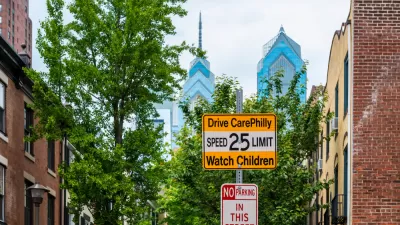Speed limits are currently determined by a calculation that considers only the status quo of vehicular velocity. Standard practices for speed limit setting and legislators should prioritize the safety of community members, according to this article.

Tiffany Chu, founder of transportation company Remix, asserts that American we need to rethink the way we set speed limits in the United States. While transportation laymen may hope that speed limits are set by a calculation determining the safest rules for traveling by car in a given space, the reality it that safety considerations are simply not a part of the calculation. Instead, says Chu, speed limits are set "by the speed at or below which 85 percent of the motorists drive on a given road, an outdated guideline promoted by the Federal Highway Administration (FHWA)."
Chu reminds that speeding has played a part in about a third of traffic collision fatalities in the United States over the past two decades and that, given these statistics, government agencies need to revise the methods for setting speed limits and introduce speed-reducing street design mechanisms on busy roadways.
For Chu, design is at the center of the solution, pointing to a July report released by the National Association of City Transportation Officials (NACTO), which advocates for speed limits set by criteria like density and activity level in addition to designing slow zones. "We cannot usher in a multimodal future without lowering speeds and making streets safe for all users. We must support the work of those undoing harmful legacy methods, and encourage the adoption of policies that embrace and emphasize design," advises Chu.
FULL STORY: Why Slower Commutes Can Be A Good Thing

Alabama: Trump Terminates Settlements for Black Communities Harmed By Raw Sewage
Trump deemed the landmark civil rights agreement “illegal DEI and environmental justice policy.”

Planetizen Federal Action Tracker
A weekly monitor of how Trump’s orders and actions are impacting planners and planning in America.

Why Should We Subsidize Public Transportation?
Many public transit agencies face financial stress due to rising costs, declining fare revenue, and declining subsidies. Transit advocates must provide a strong business case for increasing public transit funding.

Phoenix Announces Opening Date for Light Rail Extension
The South Central extension will connect South Phoenix to downtown and other major hubs starting on June 7.

How Housing as a Financial Product Harms Communities
Institutional buyers who treat housing as an investment product become disconnected from the impacts of higher rents, displacement, and housing instability.

Blinded by the Light: When Brighter Headlights Decrease Safety
Bright LED headlights can create glare and reduce visibility for other drivers and pedestrians.
Urban Design for Planners 1: Software Tools
This six-course series explores essential urban design concepts using open source software and equips planners with the tools they need to participate fully in the urban design process.
Planning for Universal Design
Learn the tools for implementing Universal Design in planning regulations.
Caltrans
Smith Gee Studio
Institute for Housing and Urban Development Studies (IHS)
City of Grandview
Harvard GSD Executive Education
Toledo-Lucas County Plan Commissions
Salt Lake City
NYU Wagner Graduate School of Public Service





























